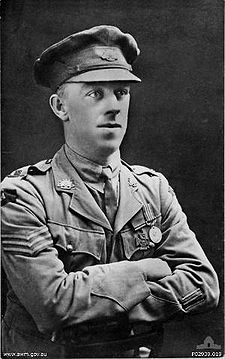George Julian Howell | |
|---|---|
 Sergeant George Howell c.1917 | |
| Nickname(s) | "Snowy"[1] |
| Born | 19 November 1893 Enfield, New South Wales |
| Died | 23 December 1964 (aged 71) Perth, Western Australia |
| Allegiance | Australia United States |
| Service | Australian Imperial Force Citizens Military Force United States Sea Transport Service |
| Years of service | 1915–1918 1939–1941 1944–1945 |
| Rank | Staff Sergeant |
| Battles / wars | |
| Awards | Victoria Cross Military Medal |
George Julian "Snowy" Howell, VC, MM (19 November 1893 – 23 December 1964) was an Australian recipient of the Victoria Cross, the highest decoration for gallantry "in the face of the enemy" that can be awarded to members of the British and Commonwealth armed forces. Howell was decorated with the Victoria Cross following his actions during the Second Battle of Bullecourt, in which he ran along the parapet of a trench bombing the German forces attacking his position through the use of grenades, and thus driving them back.
Born in a suburb of Sydney, New South Wales, Howell was employed as a builder before enlisting in the Australian Imperial Force in June 1915. Allotted to the force's 1st Battalion, he served at Gallipoli prior to transferring to the Western Front. Participating in the Somme offensive of 1916, Howell was wounded at Pozières and promoted to corporal in early 1917. During an attack on a German held village, he led a rifle bombing section and was awarded the Military Medal for his actions. Severely wounded in his Victoria Cross action, Howell underwent a prolonged hospitalisation period before returning to Australia and receiving his discharge on medical grounds. Settling in Coogee, he gained employment by working on the advertising staff of several newspapers. Following the outbreak of the Second World War, Howell served with the Australian Eastern Command Headquarters but soon sought his discharge and enlisted with the United States Sea Transport Service. He died in 1964 at the age of 71.